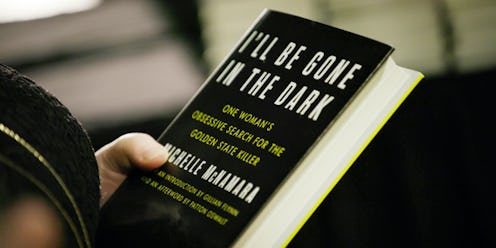Entertainment
How Decades Of True Crime Sleuthing Led Michelle McNamara To The Golden State Killer

HBO's adaptation of Michelle McNamara's book I'll Be Gone in the Dark is just as much about the late author as it is her search for the Golden State Killer. The true crime enthusiast spent the final years of her life chasing the elusive serial killer, but her story started long before, when she was 14. According to Vulture, it was then that an unsolved murder occurred just steps from her home in Illinois, leaving McNamara haunted by "the specter of that question mark where the killer's face should be." The idea that a murderer could just vanish into the night while a victim's family continued to grieve deeply bothered the writer, so in 2006 she started the blog True Crime Diary to discuss cold cases.
The Golden State Killer held particular interest for McNamara because of how old the case was. He terrorized California from 1976 until July 1986, raping over 50 women and killing 13. Yet he was never caught. Described as a white man in a ski mask, he would break into homes at night and assault young sleeping women. He was initially known as the East Area Rapist, and it took 15 years for authorities to even make the connection that he was the same person as the one known as the Original Night Stalker in Southern California. He was meticulous about not leaving evidence, and back then, they didn't have any reliable DNA testing.
McNamara's research into the case led her to write “In the Footsteps of a Killer,” a 2013 feature for Los Angeles Magazine that eventually grew into the book I'll Be Gone in the Dark — a title taken from a line that the killer whispered to one of his victims.
But McNamara never finished the book; she died suddenly in her sleep on April 21, 2016 due to a combination of drugs in her system and an undiagnosed heart condition. After her death, her husband, the actor and comedian Patton Oswalt, realized he had to complete her life's work. "Knowing how horrible this guy was, there was this feeling of, you're not going to silence another victim," Oswalt told the New York Times. "Michelle died, but her testimony is going to get out there.”
Oswalt enlisted the help of Billy Jensen, an investigative journalist, and Paul Haynes, a co-researcher in the book, to comb through McNamara's notes and over 3,500 computer files. The finished product, published in February 2018, reflects this collaborative nature. The book begins with McNamara's completed chapters, which recount the killer’s attacks and examine his methodology. Subsequent chapters are less tidy: one is just a transcript of her interview with a Contra Costa criminalist, while another is just her notes with disclaimers on them. Near the end of the book, an editor's note explains how Haynes and Jensen were brought in to "tie up loose ends" and organize the materials she left behind. They describe what they found on her laptop — notes, maps, and photographs — and lay out possible theories. Finally, they explore how McNamara believed in the potential of running DNA through genealogy databases to finally catch the Golden State Killer.
I'll Be Gone in the Dark went on to hold the No. 1 spot on the New York Times nonfiction best-seller list for 15 weeks. Two months later, on April 25, 2018, the Sacramento Police announced they had arrested 72-year-old Joseph James DeAngelo, whose DNA matched the killer's. (DeAngelo's trial is still ongoing, but he has offered to plead guilty).
Though Sacramento County Sheriff Scott Jones told reporters that McNamara's work only helped to maintain public interest in the case, her colleagues and loved ones believe McNamara and I'll Be Gone in the Dark played a pivotal role in solving it.
Fittingly, the book ends with a letter from McNamara to the killer. In predicting that he would get caught soon, she wrote, “This is how it ends for you.”